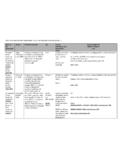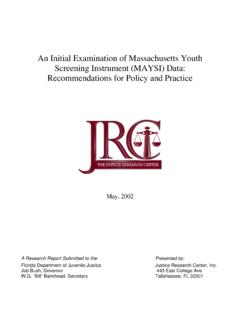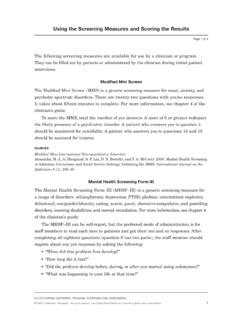Transcription of Measuring child exposure to violence and mental health ...
1 487. Measuring child exposure to violence and mental health reactions ARTIGO ARTICLE. in epidemiological studies: challenges and current issues Crian a, viol ncia e sa de: desafios e quest es atuais Cristiane Seixas Duarte 1. Isabel Altenfelder Santos Bordin 2. Genevieve Rachel Green 1. Christina W. Hoven 1. Abstract This paper examines challenges and cur- Resumo Este artigo examina os desafios e perspecti- rent issues involved in Measuring exposure to differ- vas atuais envolvidos na mensura o da exposi o a ent types of violence which are associated mental diferentes tipos de viol ncia e problemas de sa de health problems in children and adolescents. Stan- mental em crian as e adolescentes. Instrumentos pa- dardized measures suitable for epidemiological stud- dronizados apropriados para estudos epidemiol gi- ies, selected based on their relevance in the current cos, selecionados com base em sua relev ncia na lite- literature, are briefly described and commented.
2 The ratura, s o brevemente descritos e comentados. A. assessment of child 's exposure to violence may focus avalia o de exposi o viol ncia em crian as pode on a specific event ( , kidnapping), a specific con- dizer respeito a um evento espec fico (como seques- text ( , war) or even of a certain type of exposure tro) ou um contexto espec fico (como guerra) ou ( , intrafamilial physical violence ). The assessment mesmo um determinado tipo de exposi o (como of child mental health after exposure to violence has viol ncia f sica intrafamiliar). A avalia o da sa de traditionally focused on posttraumatic stress disor- mental infantil ap s a exposi o viol ncia tradici- der (PTSD) most frequently measured through non- onalmente concentrou-se na avalia o do transtor- diagnostic scales. However, other mental health re- no de estresse p s-traum tico (TEPT) freq ente- actions may be present and screening as well as diag- mente avaliado atrav s de escalas n o-diagn sticas.
3 Nostic instruments which may be used to assess these Por m, outras rea es psicol gicas podem ocorrer e reactions are also described. Two issues of emerging instrumentos que podem ser usados para avaliar es- importance - the assessment of impairment and of tas rea es tamb m s o descritos neste artigo. Dois traumatic grief in children are also presented. t picos de import ncia emergente a avalia o de Availability of culturally appropriate instruments is preju zo funcional e do pesar traum tico em crian- a crucial step towards proper identification of child as s o tamb m apresentados. Instrumentos cultu- mental health problems after exposure to violence . ralmente apropriados s o essenciais para a identifi- 1. Division of child and Key words Posttraumatic stress disorder (PTSD), ca o de problemas de sa de mental em crian as ap s Adolescent Psychiatry Trauma, child psychopathology, Epidemiology, Mea- a exposi o viol ncia.
4 1051 Riverside Drive Unit #43 New York NY 10032. surement, violence Palavras-chave Transtorno de estresse p s-trau- duartec@ m tico (TEPT), Trauma, Psicopatologia infantil, Epidemiologia, Mensura o, Viol ncia 2. Setor de Psiquiatria Social, Departamento de Psiquiatria, Escola Paulista de Medicina, Unifesp. 488. Duarte CS et al. Introduction uation may be to understand the impact of a spe- cific event ( , school shooting), of a specific con- The assessment of children's behaviors and emo- text ( , war) or even of a certain type of exposure tions after they had been exposed to extreme vio- ( , child sexual abuse). In some cases, the aim is lence poses unique challenges compared to the as- to collect information about a wide range of po- sessment of adults. First, developmental stages need tentially traumatic events.
5 To be considered, as measurement strategies will Event-specific assessments5 have to be devel- most likely differ when assessing children in vary- oped for each study. In these cases, the quality of ing stages of development. As a general rule, the the questions used is dependent on researchers' level younger the child , the more limited are our options of knowledge about the specific event of interest as to appropriately evaluate her or his mental health . well as the different ways it may have represented a Second, when the goal is to learn about children's threat for children6. After the September 11, 2001. reactions, different informants may be required. The attack to the World Trade Center, for example, it choice of the optimal informant may depend on was very crucial to recognize, that even though very the type of reactions of interest (internalizing or few children were physically present in the area, externalizing behaviors?)
6 , the age range (early child - their parents were directly exposed7,8. hood or adolescence?) and logistics (is it feasible to Instruments Measuring child exposure to trau- interview parents and children?). matic contexts have also been developed. Such in- The challenges inherent to the assessment of struments, although obviously context-dependent, youth populations are combined with the challenges can be used across different studies. In many in- pertaining to the epidemiological measurement of stances, however, supplementation with questions psychopathology related to exposure to violence . unique to each particular context may be desirable. As we know, this type of evaluation is a two-step Examples are instruments addressing children's ex- process; including both a detailed characterization posure to war9,10 or community violence3,11,12.
7 Of the person's exposure as well as of the reactions Systematic assessment of certain types or do- possibly related to such exposure . This paper, rather mains of potentially traumatic events experienced than aiming to describe a large number of mea- by children is also frequently carried out. Children sures used in post-disaster contexts1-3, focus on a can be physically or emotionally abused or neglect- few selected measures which can be used to assess ed. Sexual abuse is another type of child traumatic both exposure to traumatic events and symptoms exposure . These experiences may occur as part of a in children which could be related to the traumatic specific event13 or context (war-related rape). They exposure . The measures included were used recent- may be a one-time event, but in many cases abuse ly in key studies addressing the impact of violence and neglect become part of day-to-day lives of chil- and the development of child psychopathology.
8 Dren. The Childhood Trauma Questionnaire14 is Whenever a measure had already been used and/ an example of a self-administered retrospective or tested in Brazil, we included information about instrument used with children as young as 12 years. such use. Because our interest is learning about Another example is the Conflict Tactics Scale populations and not to conduct clinical, detailed (CTSPC)15, which can be used to gather parental assessments of a few individuals, we only consid- and child reports of intrafamily conflict or vio- ered measures that do not require administration lence involving a child . A Portuguese version of the by clinicians. We finalize the paper by calling atten- CTSPC is available16. tion to two issues we consider critical to the field: In Brazil, a population-based study (Brazil- the assessment of impairment and of the emerging SAFE) was conducted to evaluate the magnitude notion of traumatic grief in epidemiological as- of different forms of intrafamilial physical violence , sessments involving children.
9 As part of the WorldSAFE, a multi-country project involving researchers from Brazil, Chile, Egypt, India, the Philippines, and the United States17. The assessment of child exposure to violence pilot stage of the study18 examined a probabilistic sample of 89 children (0-17 years) and found a Determining the impact of exposure to violence on high prevalence of severe physical punishment children starts with proper assessment of the de- ( ), defined as shaking (if age <or= 2 years), gree and quality of children's exposure to possible kicking, choking, smothering, burning/scalding/. stressors. assessment options range from the fre- branding, beating, or threatening with weapon. The quently used brief checklists to lengthy, seldom pilot investigation was followed by a more com- employed, detailed interviews4.
10 The goal of an eval- prehensive assessment19. 489. Ci ncia & Sa de Coletiva, 14(2):487-496, 2009. The WorldSAFE Core Questionnaire on Do- brevity of evaluation is frequently a major require- mestic violence investigates intrafamilial violence ment24,25. Traditionally investigators have chosen and associated factors (original questionnaire in to focus on posttraumatic stress reactions after English developed by the WorldSAFE steering com- disasters rather than conducting a more compre- mittee and copyrighted in 1998). It includes 33 items hensive assessment of child psychopathology26. representing different child -rearing behaviors from Therefore, the field of child trauma has produced mother and/or her husband/partner in the last 12 and repeatedly used a number of brief rating scales months.

















